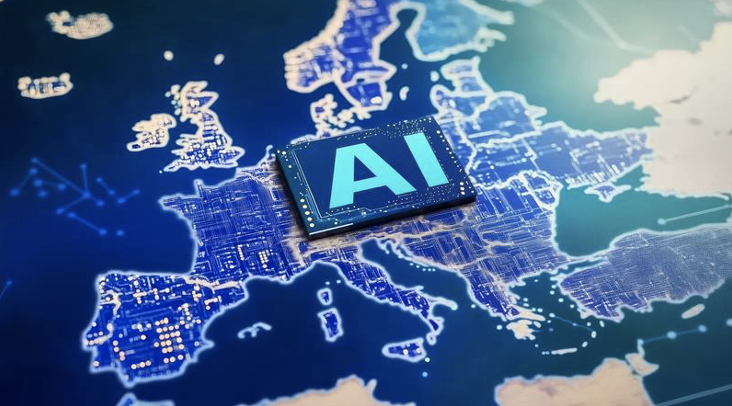
The European Union has embarked on an ambitious journey to position itself as a global leader in AI development and application. This push comes at a critical time as rapid technological advancements and geopolitical shifts reshape the global economic landscape, while the EU faces challenges such as declining productivity and an aging population.
Considering this pivotal period, we need to discuss both the potential opportunities as well as the key challenges associated with the current EU AI investment plans.
EU’s new AI initiatives
In early 2025, the EU launched two major initiatives that represent a significant shift in scale and ambition: the EU AI Champions Initiative and InvestAI. These programs collectively mobilise around €200 billion (US$209 billion), demonstrating a concerted effort to accelerate AI innovation and adoption across the continent.
Launched at the AI Action Summit in Paris, the EU AI Champions Initiative brings together more than 60 European companies committed to making Europe a world leader in AI. The initiative focuses on several critical areas such as regulatory simplification, secure data-sharing frameworks, accelerated AI investments, developments of AI infrastructure through public-private partnerships, and EU-wide initiatives to improve public understanding of AI and support skills development.
Complementing the industry efforts, the European Commission’s InvestAI program aims to mobilise an additional €50 billion (US$51 billion). A highlight of this program is a €20 billion (US$21 billion) fund for AI gigafactories, which will support four future AI facilities focused on training the most complex and largest AI models. These gigafactories will be equipped with around 100,000 last-generation AI chips, providing companies of all sizes in the EU access to large-scale computing power.
The overall package, announced at the Paris AI Summit, follows a January 2024 announcement of investments for small European businesses focused on developing ‘trustworthy’ AI that respects EU values and rules. This initiative is complemented by administrative changes within the Commission, including the establishment of a regulatory office to oversee the enforcement of the EU AI Act and the creation of an AI Research Council.
Structural Challenges
The EU’s investment strategy faces several structural challenges. Europe contends with a fragmented venture capital ecosystem, more conservative investment approaches, and a historical trend of highly skilled professionals, particularly in AI and technology, leaving Europe to work in countries with better funding, resources, and career opportunities. These factors have traditionally hampered the region’s ability to match the massive private investments seen elsewhere.
A critical hindrance to the EU’s AI investment plans is the reliance on government funding. The EU AI Champions Initiative and InvestAI are government-driven programs meant to stimulate AI investment; however public funding alone cannot replace the fast-moving, high-risk nature of private investment. Without greater participation from European VC firms, AI startups may continue to face difficulties securing large-scale funding.
Additionally, European funding mechanisms, particularly those tied to EU programs, often involve bureaucratic hurdles that slow down capital deployment. This contrasts with the fast and flexible funding environments of Silicon Valley or Beijing, where AI companies can secure millions in a matter of weeks.
Furthermore, the EU AI Act places significant regulatory demands on AI companies, particularly those operating in high-risk sectors such as healthcare, finance, and critical infrastructure. These businesses must undergo external audits, ensure algorithmic transparency, and comply with strict documentation requirements.
Also, companies developing high-risk AI applications must allocate substantial resources for compliance, including external audits (costing upwards of €200,000 annually for large firms), hiring legal and compliance teams to oversee risk assessments, and adjusting AI model architecture to meet transparency requirements.
The transparency mandates of the AI Act raise concerns about intellectual property protection. While disclosure enhances trust, companies fear that revealing their methodologies could enable competitors to reverse-engineer their models, potentially diminishing Europe’s competitive advantage in AI innovation.
European AI companies face pre-market approval processes for high-risk AI applications. This could delay product launches, making it difficult for European firms to keep pace with global competitors.
Finally, looking at this from a UK-specific perspective, the UK, along with the US, refused to sign the Paris summit’s declaration on ‘inclusive and sustainable’ AI, effectively excluding themselves from collaboration and cooperation with the EU’s AI project. While neither of these countries are a member of the EU, the split between the major Western forces behind AI may present some future difficulties such as limitations on EU AI growth outside the continent; an inability to collaborate (especially with the UK) on scientific or medical innovations that could offer global benefits; and a disadvantageous siloing of AI development.
The Unique Opportunities
Despite what the critics say, however, the independence forced upon the EU in its AI strategy may be turned to its advantage. Instead of compromising its values and ethics, the EU will be able to oblige other countries hoping to interact with its AI program to meet the region’s regulatory requirements in the same way that adequacy decisions are required for foreign countries to process Europeans’ personal data. As such, Europe could enforce global adoption of AI ethics and controls without having to negotiate.
Furthermore, as businesses worldwide grapple with uncertain AI governance, Europe offers a predictable environment where companies understand the rules of engagement. This regulatory certainty, coupled with the EU’s strong technical universities and growing startup scene, creates unique investment opportunities in sectors, which have no choice but to prioritise responsible AI.
The healthcare sector stands to benefit immensely from AI advancements, particularly in areas that require high precision, efficiency, and ethical considerations. The EU’s regulatory clarity provides an environment where AI-driven healthcare solutions can be developed and deployed with strong oversight, ensuring safety and compliance with data protection laws such as the GDPR and the EU AI Act.
For example, AI-driven drug discovery platforms can significantly shorten the timeline for bringing new drugs to market. By using machine learning to analyse biological data and predict how different compounds interact with the human body, pharmaceutical companies can develop new treatments more efficiently. The EU’s investment in AI gigafactories could provide the necessary computing power to train advanced biological models for drug design.
Overall, Europe’s focus on responsible AI ensures that these innovations comply with ethical guidelines, particularly in handling sensitive patient data and ensuring that AI-driven medical decisions remain transparent and explainable.
The financial sector has been an early adopter of AI, with applications spanning from fraud detection to investment strategies. However, the EU’s focus on transparency and fairness presents a unique opportunity for European firms to lead in responsible AI applications within finance.
AI can analyse vast datasets to detect fraud patterns and predict credit risks more effectively. By leveraging deep learning models trained on historical financial data, banks and insurers can assess loan eligibility, detect suspicious transactions, and prevent financial crime. The EU’s emphasis on ethical AI ensures that such tools are developed with bias mitigation strategies, promoting fairness in lending and financial decision-making.
Governments across the EU are increasingly leveraging AI to improve public services, enhance urban planning, and ensure efficient resource allocation. Unlike other global AI leaders that often prioritise surveillance-based AI, Europe’s approach emphasises ethics, privacy, and citizen engagement.
AI is actively being utilised by European governments to track climate change impacts, optimise renewable energy distribution, and predict natural disasters more effectively. By leveraging satellite imagery and machine learning, policymakers can monitor deforestation, track air quality, and enforce environmental regulations.
Overall, by embedding trust, transparency, and human-centric principles into its AI strategy, the EU is creating a unique investment landscape where responsible AI innovation can thrive. These sector-specific opportunities not only strengthen Europe’s technological leadership but also ensure that AI advancements serve society, the economy, and the environment in a sustainable manner.
The strategic path forward
To conclude, the InvestAI package and its attendant programs and institutions seem to be a strong proposition. The focus on benefits beyond pure profit is refreshing and embodies the hopes the world had for AI when it was first mooted as a possibility.
The EU’s approach acknowledges that the most valuable AI systems will be those that earn widespread trust through demonstrable safety and ethical operation. By embedding human values directly into its investment strategy, the EU is betting that the future of AI belongs not to those who move fastest, but to those who move most responsibly.
The success of this approach will hinge Europe’s ability to translate regulatory leadership into investment advantage, which would involve ensuring that compliance does not become a bottleneck for growth. If successful, the EU may demonstrate that in AI, as in other domains, the most sustainable path forward balances ambition with responsibility and growth, with reason.




